The Castle of Cagliostro
Oft-overlooked debut feature gem from Japanese master Miyazaki that's high on character and action.
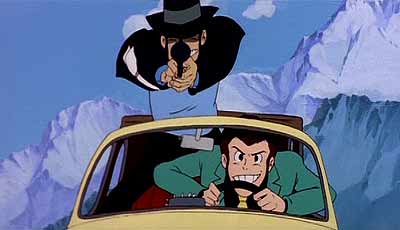
It's sometimes easy to forget but even legends have to begin their cinematic careers somewhere. The Castle of Cagliostro (to give it the most convenient of it's many titles) is that place for Hayao Miyazaki, icon of Japanese animated movies. Having previously worked on animated series for T.V., including two episodes of a Lupin serial, Miyazaki was understandably eager to fulfil his vision of working on a much broader canvas, one about the size of a cinema screen to be exact. Although in the future he would be a master of his own free will, creating characters and scenarios of his own design, for now the studios would supply the unproven young genius with their own well-established assets. It is to his immense credit then, that Miyazakis' twist on the ongoing Lupin legend bears so many of the traits that would become recognisably his own, whilst remaining firmly within the framework of an established and much-loved franchise.
For those not in the know, Lupin, or Arsene Lupin III to give him his full title, is the hero of a long-running Japanese franchise spanning comics, television and cinema for well over four decades. Originally created by Japanese comic artist Monkey Punch, the inspiration for the series comes from a series of French novels published in the 20's of which a character called Lupin was the hero. A loveable rogue, adventurer and thief, Lupin ran rings around the Parisian police and spawned several successful sequels. Imagining his own Lupin as the Japanese grandson of that hero, Monkey Punch transported the same ideas into modern Europe, Lupin III now being chased by arch nemesis Inspector Zenigata of Interpol.
The Lupin series presents a series of problems for any new director. With a well-established background and a plethora of unique characters each with their own intricate history, it would seem there is little room for anyone to stamp their own individual style upon the series, yet that is exactly what Miyazaki saw the opportunity to do. The way he saw it, if he stayed true to the characters and created an interesting plot for them to flourish in the movie would take care of itself. Add a little bit of the as yet unseen Miyazaki magic, and The Castle of Cagliostro turned out to be a superbly enjoyable adventure yarn that pleased Lupin fans and newcomers alike. Although beginning to show it's age a little, the film still retains much of it's magic, but of most interest to modern viewers will be the opportunity to see many of Miyazaki's identifiable traits emerging for the first time.
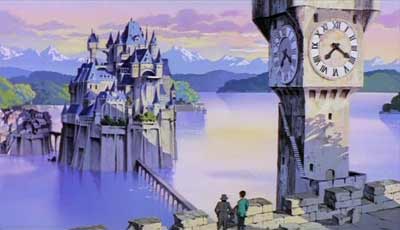
Beginning with a daring casino robbery by Lupin and longtime sidekick Jigen, the movie kicks off in formidable style with a comical failed chase scene that propels us into the credits and gives us a taste of the humour to come. Realising the $5 billion they've just stolen is counterfeit money, Lupin and Jigen decide to take an adventurous little detour and discover the source of the "goat bills". They head for the suspected source of the money, the small Duchy of Cagliostro; the UN's smallest member state with a population of 3,500 and immediately reminiscent of the fantastic European locations Miyazaki would return to in films like Laputa: Castle in the Sky and Porco Rosso.
No sooner are they across the border than the duo find themselves in a precarious cliff-edge car chase. A young woman in a bridal gown is being chased by a motor full of machinegun-toting goons, and ever the showmen Lupin and Jigen give chase, stopping the goons but realising the young woman is unconscious at the wheel of her vehicle. An Indiana Jones-style rescue effort later, Lupin finds himself hanging from the cliff, grappling hook in one hand, unconscious girl in the other. When she comes around the pair drop to the rocks below, knocking Lupin unconscious. The mysterious young girl makes her getaway but is recaptured by more of her pursuers and spirited away (pardon the pun) onboard a steamboat.
Lupin and Jigen hit the road again, heading to the heart of Cagliostro to continue their quest. Having last visited the Duchy ten years previously as a young thief still wet behind the ears, Lupin is surprised to discover the old castle, home to the King and Queen has burnt down, the royal pair perishing in the flames. A groundskeeper tells Lupin the regent Count Cagliostro has assumed control of the country, and the pair track him to his somewhat impressive castle on the shore of a nearby lake. Previously divided into two houses, the Duke's "light" side and the Count's "dark" side (responsible for all the Duke's dirty work), the Count has assumed leadership of the Duchy and it soon transpires he is manipulating events to his own evil ends. A local woman explains to Lupin and Jigen that the young girl they saw, Lady Clarisse, is the Count's bride to be; last remaining member of the Duke's side of the royal family. He seems determined to wed the girl against her will, but what could his reason be? Lupin is determined to find out, and Jigen, as always, provides willing backup.
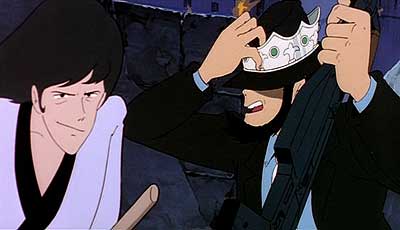
After a brief tussle with the Count's guards, Lupin surmises it's impossible to get into the castle's heavily protected grounds without a spot of trickery. Leaving a cheeky calling card on a guard's back, he sits back and awaits the arrival of his long time foil Inspector Zenigata. Upon his arrival, Lupin uses his mastery of disguise to impersonate the inspector, gaining entry to the castle grounds and heralding the start of a non-stop barrage of comedic incidents.
Although what transpires beyond this point is fairly standard action-adventure genre stuff, The Castle of Cagliostro succeeds in being unique through it's use of devilish humour and superb characterisation. Lupin himself is a wonderful character, and despite operating rather decidedly within the grey area of morality it's hard not to become involved by his cheeky charm. Small wonder he's such a ladykiller, Lupin soon mounts a rescue attempt on Lady Clarisse and the young girl falls head over heels for her charming would-be saviour. A Japanese twist on Cary Grant, James Bond and Delboy Trotter, Lupin is the archetypal rogue with a heart of gold, but charm alone will not get him through this particular adventure.
Jigen has been Lupin's companion for time immemorial, and although having a fair few adventures of his own is always on hand when his buddy needs help. Reputedly the best marksman in the world, the time Jigen spent in America is reflected in his Western style of clothing and laid-back attitude. More likely to rely on his anti-tank rifle or magnum than his charm and wit like Lupin, Jigen is nonetheless an engaging and likeable chap who, like his friend, is an intrinsically decent bloke at heart. Further backup comes from Goemon, a sword-wielding young practitioner of the samurai way who refuses to discard discipline and honour and absolutely will not give up his ancient ancestral sword Zantetsuhen in favour of modern firearms, and Lupin's on-off lover and rival Fujiko; a young woman with a spirit for adventure and a penchant for grenades and Uzi's that would put even Schwarzenegger to shame.
Eventually imprisoned in the castle's flooded dungeon, Lupin turns to Inspector Zenigata (who Lupin himself trapped in the dungeon previously) for help, agreeing to a truce for the duration of their escape. Zenigata has been a figure in the Lupin stories since their conception and by now he is a grizzled, weary soul who you feel is on the verge of psychological imbalance due to his neverending pursuit of Lupin. Reluctantly agreeing to join forces, Zenigata finally gets his moment of glory when he and Lupin discover the castle's currency forging equipment, an act for which Lupin allows him to take the credit in the film's final showdown.
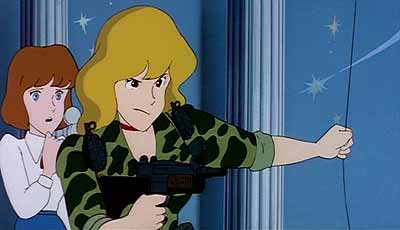
As Lupin works his way closer to the Count and the rescue of Clarisse, he discover's the nature of the ruler's evil scheme. In uniting the long-separated houses of the royal family by marriage, he will be able to use the two rings bearing the insignia of each to unlock a great hidden treasure within the castle's clock tower at midnight on the evening of the ceremony. Determined to spare Clarisse from such a barbaric fate as the marriage, Lupin launches a last-gasp rescue attempt but is foiled, being seriously wounded in the process, and he and his companions are forced to regroup. After remaining comatose for three days, Lupin awakes on the eve of the marriage and hastily formulates a plan that will save Clarisse, ruin the Count, and vindicate Zenigata who has been refused permission to close down the Count's activities by a bureaucratic Interpol council.
Kidnapping the priest who is to carry out the service, Lupin again uses his powers of disguise to infiltrate the ceremony as the holy man, foiling the COunt's nefarious plot at the eleventh hour and precipitating a frenzied pursuit through and across the castle grounds. Zenigata meanwhile takes a camera crew (headed by Fujiko) into the basement where he 'happens' to discover the printing equipment on live T.V., instantly making him a national hero (if not a great actor, as one of his Interpol colleagues points out).
Lupin's pursuit by the Count and his men culminates in an exciting chase up the inside of the clock tower, working his way through the giant cogwheels and mechanisms before emerging on the clockface itself, a sequence that tips it's hat to a certain Mr. Charles Chaplin. Confronted on the clockface by the Count with a captive Clarisse in tow, Lupin's wit must come into play if he is to prevent the Count from achieving his goal and no doubt snuffing out the lifeforce of our hero while he's at it. And how does the encounter culminate? It'd hardly be fair to tell you that now would it?
As the story comes to it's conclusion it is apparent that the young man responsible for it's conception has something of a talent for the fantastic and an eye for character unlike many others. Even more impressive when you consider the film went from conception to screening in cinemas within seven and a half months, with less than five months of production time; an insane schedule by anyone's standards, with Miyazaki apparently stating he would have liked an extra month! No kidding...
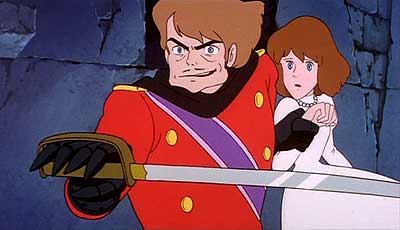
While it may not represent iconic Miyazaki at his best, The Castle of Cagliostro still offers rewarding viewing thanks to it's depth of characterisation, lush fantasy setting and the first emergence of Miyazaki's unique style and familiar themes. Set in a land that has all the now-familiar fantasy elements of classic Miyazaki, The Castle of Cagliostro has many parallels with the likes of Laputa: Castle in the Sky in it's European landscape trapped between the past of glorious castles and rule by royal decree, and the technological present of buzzing gyrocopters and clapped-out yellow Volkswagen Beetles. Although not the movie's main theme by any stretch of the imagination, this machine versus nature element would later resurface in many of Miyazaki's films, most notably Princess Mononoke and the earlier Nausicaa of the Valley of Wind. Indeed more notable is the theme of dark versus light, represented here by the 'Dark' house of the Count and the 'Light' ancestry of Clarisse. Our hero Lupin rather admirably walks the tightrope between both.
The movie also showcases Miyazaki's impressive attention to detail in researching his characters and locations, drawing influence from both the real world and other media sources for almost every aspect of his creation. From the royal wedding in the small duchy (surely reminiscent of the marriage between Grace Kelly and Prince Rainier of Monaco) to the Count himself, apparently inspired by real life con artist Guiseppe Balsamo who often used the name Count Alessandro of Cagliostro, every facet of the film presents a rich source of history providing both a fantastic realism and a sense of depth to the proceedings.
Of most importance in this reviewer's opinion is the brilliant characterisation. The Lupin legacy provides a rich source of character for Miyazaki to work with and he has done the series' fans proud here. Roping in the most popular of these familiar faces, the director manages to make their presence both entertaining and justified. Nobody is here purely for show; from Goemon with his righteous reflection of truth, honesty and respect for tradition to Fujiko, whose presence reminds Lupin in the face of his growing fondness for the young Clarisse that he is no longer the young irresponsible man he once was, every character has if not their own agenda then at least their own relevance within the movie's moral framework.
Most of all, The Castle of Cagliostro represents fantastically paced humour and action that most films, animated or otherwise, would give their last thousand feet of celluoid to capture. Two hours of unashamedly escapist action and adventure that never outstays it's welcome, this film is the kind you sometimes forget even exists. Romance as a pursuit of it's own without the intrusion of sex, fantasy settings that seem almost surreal were it not for their founding in the existent, and friendship as the most lasting and important of virtues. Who'd have thought such sentimental, romantic tosh could ever be so engrossing? They sure don't make them like this any more. Well, other than Miyazaki, of course...
From my island of objectivity I award this movie 4 out of 5 Disko Units.
Taro Ishida (Count Cagliostro)
Kiyoshi Kobayashi (Daisuke Jigen)
Goro Naya (Inspector Zenigata)
Sumi Shimamoto (Lady Clarisse)
Eiko Masuyama (Fujiko Mine)
Makio Inoue (Goemon Ishikawa XIII)